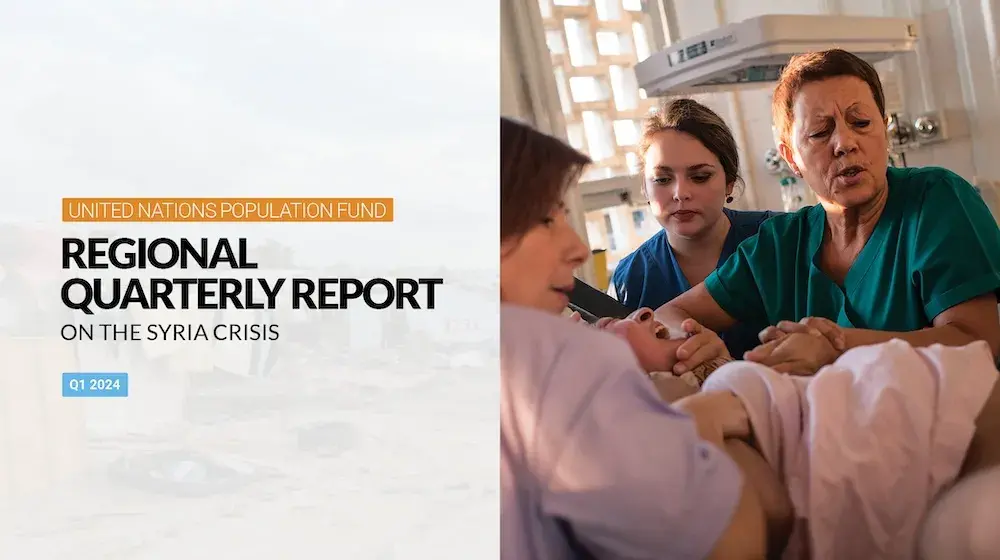The population of the Arab region is youthful. One in three people are aged 14 years or younger. More than one in five people are aged between 10 to 24 years. The aspirations and achievements of these young people will shape the region’s future.
Countries with both increasing numbers of young people and declining fertility have the potential to reap a ‘demographic dividend’ – a boost in economic productivity that occurs when there are growing numbers of people in the workforce relative to the number of dependents.
UNFPA works with governments, civil society, communities and other partners, to encourage policies that can help realize this dividend where the opportunity exists. Such policies include improving access to quality education and jobs, as well as investing in the health, particularly the sexual and reproductive health, of young people.
The transition
To realize a demographic dividend, a country must undergo a demographic transition – a shift from high fertility and mortality to low fertility and mortality. Mortality generally falls as child survival rates improve, mainly because of improved health and sanitation standards. Declines in fertility often follow, and as families have fewer children, household resources are freed up to make investments in their long-term well-being.
Over time, the children born during the early stage of this transition enter the labour force. When the labour force grows more rapidly than the population dependent on it, resources become available for investment in economic development. This offers an opportunity for rapid economic growth – if the right social and economic policies and investments are in place.
Taking the right actions
To make the most of a demographic dividend, countries with falling fertility rates must undertake specific actions to empower young people to fulfill their potential. This includes encouraging decent work, investing in education, and ensuring access to adequate nutrition and health – including unrestricted and universal access to sexual and reproductive health care.\
Sexual and reproductive health is key to reaping the gains from a demographic dividend. When women are empowered to plan the number and spacing of their children, fertility levels tend to fall. Sexual and reproductive health also reduces disease and injuries, ensuring people are better able to contribute to the economy. And women with access to these services are better able to continue working, which strengthens the financial well-being of their families and communities.
The Arab region
Demographic transitions in the Arab region have witnessed a rapid decline in mortality, followed by a delayed decline in fertility. Mortality decreases started in the 1960s, and about two decades later, fertility declined in several countries. The speed of demographic transition in the region varied from one country to another, because of migration patterns such as massive labor migration and forced population displacement.
The Arab region is divided into three different demographic categories. The first group includes countries with high population growth rates (about 3 percent or more per annum) including Mauritania and a number of Gulf Cooperation Council countries. The second group shows countries with ongoing demographic transitions and growth rates of 2.5 to 2.9 percent per annum, including Egypt, Jordan, and Sudan. The last group describes countries at an advanced transitional stage with low growth rates, including Lebanon, Morocco, and Tunisia.
Conflicts, population movement, voluntary and forced migration rates, and displacement have significantly affected the increase in population size and structure in the region. The Arab region is home to some 9.3 million refugees. The number of migrant workers in 12 Arab countries reached 24.1 million in 2019. Labour migration pushes up the high population growth rates in countries within the Gulf Cooperation Council [GCC], particularly Qatar and the United Arab Emirates.
In 2020, Arab countries hosted around 41.4 million migrants and refugees, representing almost 15 per cent of international migrants and refugees worldwide. Saudi Arabia and the United Arab Emirates have the largest number of international migrants, followed by Jordan. However, unlike in the GCC countries, migrants in Jordan originate mainly from neighboring Arab countries such as Egypt, Iraq, Palestine, and the Syrian Arab Republic. At the same time, migration and forced displacement from Arab countries has continued to increase, reaching an estimated 32.8 million people in 2020, 44 percent of whom stayed within the region. The Arab region has the greatest number of refugees and displaced populations globally, with the Palestinians being the largest and oldest group. Jordan, Palestine, Lebanon, and Sudan all hold over 1 million refugees.
Family planning programmes in the Arab region are still far less effective than what is necessary to achieve a positive demographic transition. Most studies reveal that the majority of Arab states are still in pre-transition phase, notably Iraq, Mauritania, Sudan and the Comoros, or in early transition, where the percentage of the young is just beginning to increase, as in Egypt, Jordan Palestine, Algeria, Syria, Libya, Yemen, Djibouti, Bahrain and Saudi Arabia.
Some countries have managed to reach the later stages of the transition like Qatar, Kuwait, the UAE, Tunisia, Morocco, Lebanon and Oman, where lower fertility rates have allowed the youth category to be larger than that of children and elderly combined. This trend, if facilitated by adequate social policies, allows for more savings in households and better living standards.
UNFPA action
UNFPA has supported Arab countries in developing demographic profiles and producing demographic analysis, such as in Egypt and Morocco, informing government policies and national plans. The Cairo Declaration of 2013 also emphasized the benefits of the demographic opportunity while recommending:
- Improving the quality of and access to education to adequately respond to labor market needs;
- Ensuring the right of young people to decent work through effective policies that generate stable, safe, secure, non-discriminatory employment, especially in regard to gender;
- Developing youth capacity for interaction and building healthy social relations, prevent social isolation, promote conscious sexual and reproductive health awareness;
- Committing to prioritizing the creation of jobs and skilled workforce by increased investment that foster youth entrepreneurship and provide capacity building to young people;
- Actively involving young people in policies and national and regional programs;
- Enabling effective participation of young people as volunteers and leaders of social change without being subjected to exploitation, violence or deprivation of rights;
- Activating various mechanisms and joint Arab institutions dealing with youth issues for enhanced networking in support of greater efficacy and feasibility.
Updated 30 July 2024




